
BY MICHAEL J. BARAKEY
On Sunday, October 4, 2015, at 2000 hours, Virginia Task Force 2 (VA-TF2) was alerted and then activated for deployment to South Carolina, in response to Hurricane Joaquin. VA-TF2 deployed a Type 1 urban search and rescue (US&R) task force of 80 members and five canines (four live find canines and one human remains detection canine). In addition to the Type 1 task force, eight members of VA-TF2 deployed with the incident support team (IST).
Late that evening, the 12-vehicle convoy (three tractor trailers, two straight trucks, two coach tour buses, and five command/pull pickup trucks pulling four trailers) left Virginia Beach with the destination of Columbia, South Carolina. Traveling all night and through the morning, the task force arrived in Columbia on Monday, October 5, at 0900 hours.
VA-TF2’s task force leaders (TFLs) met with a Columbia (SC) Fire Department (CFD) division chief and the South Carolina incident management team (SCIMT) Operations Section chief that morning. The TFLs were briefed on the situation, were given the incident action plan for the Columbia Division, and provided intelligence on major areas or targets that needed to be searched. After reviewing maps of the area and developing a transportation plan, VA-TF2 sent a recon team to lower Richland County, which the recon team reported had not been searched by local responders (approximately 200 square miles). It was assigned to VA-TF2 as “Division D.”
The recon team consisted of search, hazardous materials, and structural specialists as well as two rescue squads. The TFL’s objective was to evaluate the division and develop a plan of engagement. While the recon team was operating, the remaining members of VA-TF2, working with the Logistics team manager, set up the base of operation (BoO) at the South Carolina Law Enforcement Academy in Columbia. This BoO was ideal for VA-TF2. The academy, close to the theater of work, had a secure site for the vehicles and equipment, space dedicated for the command and planning cell to operate, adequate meeting space for the task force, a full cafeteria, and a dormitory. When the recon team members returned to the BoO, they had the necessary intelligence to develop a plan of engagement for the next operational period.
On Tuesday morning, October 6, VA-TF2’s TFLs and Plans team managers (PTMs) attended the operational briefing conducted by the SCIMT at the CFD headquarters. At the briefing, VA-TF2 remained assigned in Division D. Supporting VA-TF2 was the Air National Guard, which provided air and ground transportation; the National Park Service (NPS); and the Department of Natural Resources (DNR). These federal assets were integrated into VA-TF2 to provide transportation, additional boats, all-terrain vehicles, and agents experienced in operating in swift water environments (photo 1).
 |
| (1) VA-TF2 members working lower Richland County. (Photos courtesy of VA-TF2.) |
The TFL divided VA-TF2, the NPS, and the DNR into two squads. Division D’s 200 square miles were also divided in half, allowing the two squads to work each part of the division. This allowed VA-TF2 to meet the SCIMT’s incident objectives, which were to search all buildings, homes, structures, and vehicles because the local responders had not had the opportunity to search that division. Additionally, the objectives were to identify road closures, utility outages, damaged structures, flooded areas, and hazardous material releases and to document the number of citizens evacuated or rescued. To accurately demonstrate the progress of VA-TF2 and to show the SCIMT the work completed while operating the division, VA-TF2 used handheld global positioning system (GPS) and geographical information system (GIS) online applications. This documentation prevented other responders or search crews from duplicating efforts and allowed the SCIMT to report the progress for each operational period.
While conducting ground searches in Division D, the IST leader redirected one of the squads to Williamsburg County, South Carolina. The squad was transported by two Blackhawk helicopters to an area that was cut off by rising waters (photo 2). The squad landed in a field and met up with Williamsburg County emergency managers, who stated their county was receiving the necessary assistance from the state of South Carolina and that they did not need federal search and rescue assets at that time. The squad was airlifted back to McIntyre Air Force Base and reunited with the other squad waiting at the forward BoO.
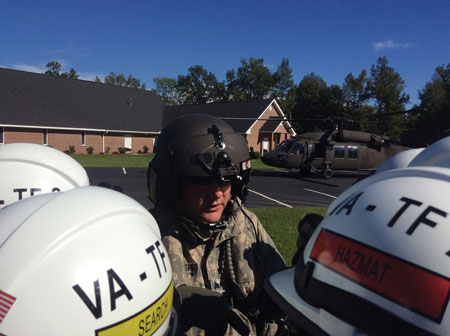 |
| (2) VA-TF2 is briefed prior to loading a Blackhawk helicopter to fly to Williamsburg County, South Carolina. |
The following two days, October 7 and 8, VA-TF2, NPS, and the DNR searched the remaining 200 square miles in lower Richland County. The teams visited 1,932 structures, marked 4,222 waypoints (flooded streets, power lines down, and damaged structures, for example), and identified 50 sites that had special considerations (photo 3). VA-TF2 located citizens who were on the opposite side of washed-out roads. These citizens, who had no access to the outside and had needs-medicine and dialysis-made sure the SCIMT had the GPS coordinates of those homes and roads so emergency road repairs could occur. In addition to searching lower Richland County, VA-TF2 provided the SCIMT with a division supervisor for the 0800-2000 hour operational period on October 7.
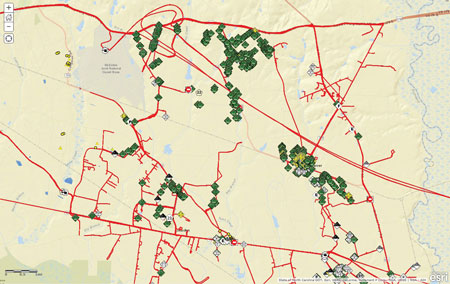 |
| (3) The tracks and waypoints of VA-TF2 while operating in lower Richland County. |
On the afternoon of October 8, 2015, VA-TF2 was relocated to Dorchester County to assist the local fire-rescue departments with search and rescue needs because of the rising floodwaters. The team was being assigned to the Santee South Division. Prior to the movement of the entire task force, a recon team went to St. George, South Carolina, to identify a suitable BoO for VA-TF2. Because schools were closed, the recon team identified Woodland High School as an ideal location for the BoO. The IMT worked with the authority having jurisdiction (AHJ) and secured the high school as the remainder of the team, cache, and vehicles arrived. Then Dorchester County’s Chief A.B. Adkinson III briefed the TFLs.
Adkinson advised the TFLs of the anticipated flooding that could inundate the Low Country as the water was moving from the midland to the coast. After the briefing, Adkinson led a recon team to the Edisto River, which was still rising; it was already above the 500-year flood level (photo 4). The Dorchester County Fire-Rescue Department (DCFR) had already performed 70 rescues on Saturday, October 3, and Sunday, October 4, and performed numerous voluntary evacuations. As the waters continued to rise, the DCFR was concerned that the residents who decided to stay in place and wait out the flooding would need rescuing.
 |
| (4) The Edisto River in Dorchester County. |
On October 9, 2015, the task force integrated with the DCFR. VA-TF2 and the NPS were divided into four water strike teams and sent to four divisions in the county. The TF strike teams consisted of water rescue technicians, search team managers, canines, physicians, medics, logistical support, hazardous materials technicians, and planning support. In constant contact with the Red IST, VA-TF2 prepared for the flooding to increase and crest on Saturday morning, October 10. VA-TF2 launched a strike force when the Dorchester County Emergency Communications Center received a call that a citizen was in need of rescue. Contact was made, but no assistance was rendered.
On October 10, Squad 2 from VA-TF2, two NPS rangers, and a Dorchester County sheriff responded as a strike team after the Dorchester County Emergency Communications Center received a 911 hang-up call from a home that was deemed accessible only from boat. The two-boat strike team launch point was a bridge that was normally a road. The Edisto River was flowing from west to east at a significant rate. The strike team traveled to the targeted home and encountered swift water from the rapidly moving currents. On arrival at the home, the team quickly discovered that the residence was vacant. The strike team then performed primary and secondary searches of 40 homes on the river (photo 5). The team identified propane tanks that floated away from structures along the river, reptiles that were fleeing the rising water, and homes that were flooded but still had electricity. The water level at the majority of the homes was at the utility meter base.
 |
| (5) VA-TF2 operates on the Edisto River. |
On Sunday, October 11, VA-TF2 was demobilized at 0900 hours. The team was met by the Red IST and the DCFR chief as they cleaned up the BoO and finalized all the paperwork. They were on the road by 0915 hours. During the eight-day mission, VA-TF2 traveled 1,244 miles by ground, 110 miles by air (Blackhawk), and 12 nautical miles on the Edisto River. The team visited 1,988 homes in Richland and Dorchester counties, marked 4,850 waypoints, and evaluated/cleared four extremely hazardous sites.
Lessons Learned and Reinforced
- Situational awareness. Develop a method to provide working responders with real-time road closures and immediate updates with dam breaches or failures. This information is essential to working members. As VA-TF2 moved across Columbia and Richland counties, roads that were once passable, to include interstate and primary roads, were being closed as the waters rose. The water continued to rise, and the threat of additional dams breaking north and west of the TF’s location required constant situational awareness of the planning team and TFLs. Additionally, the route into a targeted search area may not be the route out as the waters continued to rise. GIS tracks and GPS coordinates need to be constantly recorded and transmitted to ensure the AHJ (IMT) and FEMA (IST) are aware of a TF’s location and movement.
- Communication. Communication with members traveling away from the BoO is critical, especially when line-of-sight is not able to reach portable to portable. Responders working in disaster areas need to secure communication with the AHJ so that accountability occurs and duplication of rescue efforts does not occur.
- GPS. Proficient use and understanding of GPS units are essential when responders travel by ground, boat, or aircraft. With limited communications and cell towers that are not operational or are overtaxed, extraction points for responders may be identified only by GPS. Also, when the roads are not identifiable by street signs or landmarks, the GPS can mark waypoints and extraction points for teams and rescued civilians. USNG and/or latitude/longitude may be the only coordinate that can ensure your team is found, extracted, or rescued if needed.
- The water environment. It is challenging: All responders who operate in disaster conditions must have situational awareness when navigating unknown water and waterways-especially when the waterway is not on any map or chart. The team’s knowledge of the area and the fitness of the team (lack of sleep and the complexity of the rescue or mission can complicate the team’s ability to perform rescues as the efficiency and knowledge of the area) will hinder their capabilities. The environment includes high heat and humidity, wearing personal protective equipment like Mustang dry suits, waders, and MT94 Level B hazmat suits (for contaminated waters-i.e., fuel, chemicals from plant discharges and runoff from containment areas, raw sewage, and anything else that can float and come downstream) can tax team members. Also, when the team enters areas that are navigable only by water, the team has to be creative when traversing the boats and entering homes.
- Hazmat. Propane tanks used for heating and cooking can break away from the homes and travel with the current. Many propane tanks can be found floating and moving downstream. Have a plan to secure the tanks, shut off the valves, and mark them for remediation once the water recedes.
- Preparedness. TF members must be fully trained and highly skilled. VA-TF2 and the other national US&R teams were trained for disasters in flooded communities under the directives of the National US&R Program Office. Team members must be trained to the water rescue specialist level and know how to operate 16-foot flat-bottom johnboats in water environments. They must also procure water rescue equipment to support such missions. During the past several years, VA-TF2 has completed the many hours of required training, engaged team members in drills and retraining events, and procured the required equipment; the logistics component has readied the water rescue cache for immediate deployment.
VA-TF2 also participated in a multiagency exercise at the Guardian Centers of Georgia in Perry from September 30-October 2, 2015 (see “FDNY’s Earthquake Exercise at Guardian Centers of Georgia”). The lessons learned at the Guardian Centers training were immediately shared with the full rostered team.
MICHAEL J. BARAKEY (EFO) has been in the fire service since 1993. He is the district chief of administrative services and a shift commander with the Virginia Beach (VA) Fire Department. He was previously assigned as the commander of B shift, the chief of personnel and development, and the chief of training. He is a hazmat specialist, an instructor III, a nationally registered paramedic, and a neonatal/pediatric critical care paramedic for the Children’s Hospital of the King’s Daughters in Norfolk, Virginia. Barakey is a plans team manager for the VA-TF2 US&R team and an exercise design/controller for Spec. Rescue International, Inc. He has a master’s degree in public administration from Old Dominion University in Norfolk, Virginia, and graduated from the National Fire Academy’s Executive Fire Officer Program in 2009. Barakey is an FDIC International classroom instructor.
FDNY’s Earthquake Exercise at Guardian Centers of Georgia
By Michael J. Barakey and Kevin Shea
In the early morning hours of September 30, 2015, 17 members of Virginia Task Force 2 (VA-TF2) departed Virginia Beach, Virginia, for Perry, Georgia, to integrate into a large-scale, multiagency training exercise, sponsored by the Fire Department of New York (FDNY), at the state-of-the-art Guardian Centers of Georgia. The objectives were to challenge FDNY’s incident management team (IMT) and Special Operations Command (SOC) with a disaster that necessitated continued operational periods and the integration of state, federal, and military agencies into the exercise. The facilities at the Guardian Centers made it possible for the FDNY to achieve these objectives just as if the disaster had occurred in New York City.
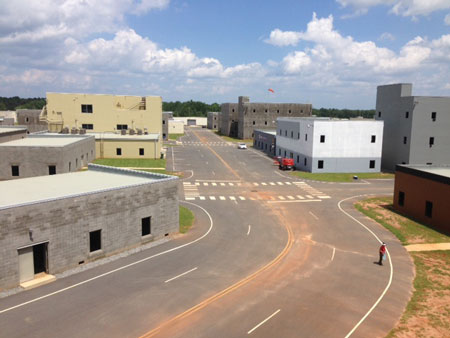 |
| (1) An overview of the Guardian Centers of Georgia Urban City. (Photos 1-4 by Kevin Shea.) |
As VA-TF2 departed Virginia Beach, a storm named Joaquin threatened the United States. Joaquin, a tropical storm the morning of September 30, churned east of the Bahamas with maximum sustained winds of 70 miles per hour. As the task force (TF) entered South Carolina, the National Weather Center upgraded Joaquin to hurricane strength. VA-TF2 was going to the Guardian Centers with the objective of exercising and refining search and rescue skills while operating in a flooded environment. This exercise proved to be a dress rehearsal for VA-TF2, which soon would be deployed for the unprecedented flooding that occurred in South Carolina as the result of Joaquin.
As VA-TF2’s caravan of vehicles, cache, and members entered Georgia, Joaquin was predicted to grow to a Category 3 storm. VA-TF2 was heading to the Guardian Centers to exercise, but Hurricane Joaquin reminded all responders and participants why it was necessary to hone and refine search and rescue skills and techniques as the East Coast braced for Joaquin’s effects.
The Training Venue
The Guardian Centers is an 830-acre disaster training facility. The disaster complex provides real-world training in a controlled yet highly dynamic and real-life environment. The idea for the Guardian Centers was conceived after Hurricane Katrina in 2005. The complex was designed so that all responders and agencies would have the opportunity to prepare for large-scale disasters in one common arena. The Guardian Centers opened in 2014 and quickly developed into a premier training facility. Specialty responders and teams can deploy and exercise command and control, operational readiness, and tactical decision making while performing the task level skills required of advanced search and rescue teams. The props, injects, and training are second to none (photo 1). The well-engineered props are meshed with the expertise of seasoned controllers who have been to large-scale disasters all over the world. The end product is a highly realistic disaster that challenges responders and incident commanders (photo 2).
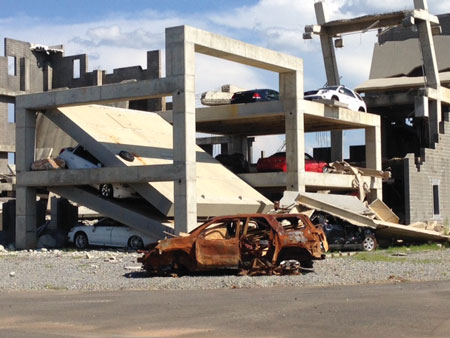 |
| (2) The well-engineered collapse mock-up at the Guardian Centers of Georgia. |
Furthermore, as fire and emergency services continue to develop and refine response capabilities, it is essential to learn from the past. Many natural and manmade disasters have occurred over the past 20 years. Unfortunately, the primary mode of training for similar or like disasters was in the classroom using tabletop exercises. Large-scale incidents like the Oklahoma City Bombing in 1995, the attacks on the Pentagon and the World Trade Center in 2001, Hurricane Katrina in 2005, and the 2010 Haiti Earthquake demonstrated the need for specialized responders to train in real-life settings (photo 3). Also, those events demonstrated the need for specialized responders to integrate with the local, state, and federal assets. The Guardian Centers provides that opportunity. Local, state, and federal emergency responders have the opportunity to actually perform the functions of incident command and disaster response in a realistic manner.
The vast size of the complex provides adequate space for emergency responders to set up a base of operations (BoO) and a command center and to deploy a fully staffed IMT. The props are well thought out and engineered to allow responders to train and execute with realism. This venue allows teams to test and validate their response to a disaster. Many scenario types and styles-from hazmat releases to water operations, elevated and below-grade rescue, bridge collapse rescue, and tunnel rescue-occur at the Guardian Centers. The controllers can challenge even the most prepared and experienced responders (photo 4).
The Guardian Centers Earthquake
VA-TF2 was participating in the exercise titled “Guardian Centers Earthquake,” which had more than 600 responders participating. About 300 of them were from New York City. The US&R assets taking part were FDNY’s SOC, the Chemical Biological Incident Response Force (CBIRF), MD-TF1, VA-TF2, CA-TF8, UT-TF1, and the 103rd National Guard.
VA-TF2 checked in with FDNY’s IMT on the afternoon of September 30. The TF immediately received a briefing from FDNY’s Operations Section chief. The initial operational period started at 1600 hours; FDNY’s SOC was already operating when VA-TF2 was paired with a 41-member Marine CBIRF team and assigned to perform wide-area search (WAS) in an urban environment. VA-TF2 and CBIRF worked side by side to identify injured and trapped civilians affected by the earthquake. While performing WAS, one squad from VA-TF2 and a squad from CBIRF were redirected to work with FDNY’s SOC in a road tunnel that had multiple trapped and pinned persons in vehicles that were crushed by falling concrete. Simultaneously, VA-TF2 and CBIRF’s other squad were assigned to work a three-story commercial building that sustained a collapse following the earthquake. The team breached an exterior wall and packaged three critically injured patients. This operational period was over at 0200 hours on October 1.
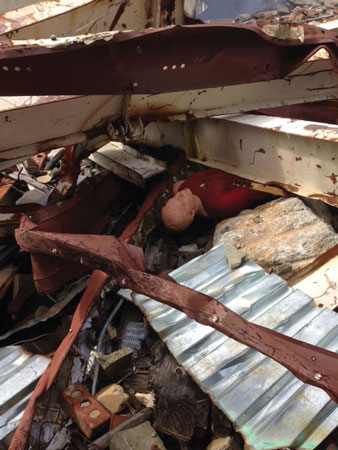 |
| (3) The collapse prop at the Guardian Centers of Georgia. |
As operations continued throughout the morning, VA-TF2’s leadership watched weather forecasts and tracked Hurricane Joaquin. The storm was intensifying and threatening the United States. At the morning’s operational briefing, VA-TF2 was assigned to operate in a neighborhood that flooded following a dam break. The TF launched five boats (four flat-bottom boats and one inflatable), searched, rescued, and removed more than 40 patients from the flooded area. This part of the exercise allowed VA-TF2 to deploy boats in the flooded environment and perform search and rescue work off a water platform.
After completing the scenario, as is the case in any disaster, VA-TF2 was immediately assigned to another task, to work with FDNY’s SOC to stabilize a three-story apartment building that had significant damage following the earthquake and subsequent aftershocks. FDNY SOC had been working the site for the entire operational period. After a pass down from FDNY’s TF leader, FDNY turned over the operation to VA-TF2. The TF shored two areas of the building identified by the team’s structural engineer. This allowed the TF to enter the floor above and perform primary searches. VA-TF2 found three patients above the shored area. Two of the three were removed by stokes basket and turned over to emergency medical services (EMS) personnel; the third was determined to be deceased (manikin) (photo 5). The basement was also searched; four patients were rescued.
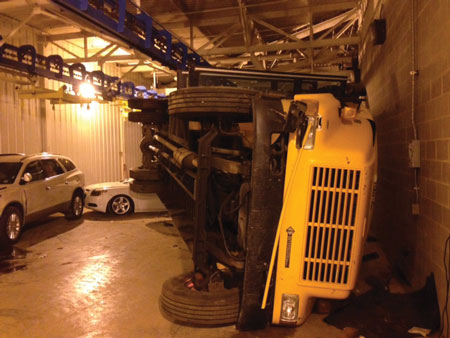 |
| (4) The tunnel prop at the Guardian Centers of Georgia. |
VA-TF2 wrapped up the operational period and went back to the BoO. After rest and rehab, at 0200 hours on October 2, VA-TF2 was assigned to work with FDNY at the flooded city while working a bridge collapse. VA-TF2 and FDNY deployed boats and performed search and rescue operations in the flooded city; transported stabilization and extrication equipment by boat to the site of the bridge collapse; and shuttled physicians, medics, and hazardous materials specialists to the flooded area for detection, monitoring, and patient care and stabilization needs-all in the rain and dark of night.
The Value of the Training Complex
During the exercise, VA-TF2 was challenged with performing WAS in the urban environment, waterborne search and rescue, working in an urban flooded environment, shoring operations, heavy lifting and moving, vehicle extrication, patient packaging and movement, detection and monitoring, multiteam integration (with FDNY’s SOC, FDNY’s IMT, and other National US&R TFs), and breaking and breaching concrete. Additionally, VA-TF2 integrated with the Marine Corps’ CBIRF team and worked side by side with 41 Marines to perform search and rescue in an urban setting, removing trapped and pinned patients in a tunnel collapse, breaching exterior walls on block buildings affected by the earthquake, and sizing up buildings affected by the earthquake. VA-TF2 worked for the FDNY’s SOC to perform a night evolution in a flooded city and swift water, rescue civilians trapped on rooftops and in attics, and rescue trapped civilians at a bridge collapse. VA-TF2’s TF leader integrated with the FDNY incident commander and Operations Section chief so that VA-TF2 was able to accomplish the incident objectives.
From the time VA-TF2 arrived on September 30 at 1630 hours to the time the team departed at 0830 hours on October 2, it had logged 26 hours of work. That realism provided stressors that can be experienced only in an actual deployment working a “real” disaster. The Guardian Centers of Georgia is the “crown jewel” of facilities for fire and emergency services exercises; emergency responders can exercise every part of a response to a disaster.
 |
| (5) VA-TF2 working at the Guardian Centers Earthquake. (Photo by Michael Barakey.) |
This mock disaster was more than breaking and breaching concrete, running boats in a flooded city, or entering a subway mockup and removing casualties after an earthquake. This exercise was equally about how an IMT can coordinate responders by integrating state and federal responders with local responders, allow the section chiefs to establish appropriate branches and groups, and enable general staff members to practice the areas of responsibility that are not routinely exercised.
Note: While traveling home on Friday, October 2, VA-TF2 was placed on alert for the flooding occurring in South Carolina as a result of Hurricane Joaquin. The TF rostered a Type 1 team and prepared the cache. VA-TF2 was activated on Sunday, October 4, and was assigned to Columbia.
Lessons Learned
MICHAEL J. BARAKEY (EFO) has been in the fire service since 1993. He is the district chief of administrative services and a shift commander with the Virginia Beach (VA) Fire Department. He was previously assigned as the commander of B shift, the chief of personnel and development, and the chief of training. He is a hazmat specialist, an instructor III, a nationally registered paramedic, and a neonatal/pediatric critical care paramedic for the Children’s Hospital of the King’s Daughters in Norfolk, Virginia. Barakey is a plans team manager for the VA-TF2 US&R team and an exercise design/controller for Spec. Rescue International, Inc. He has a master’s degree in public administration from Old Dominion University in Norfolk, Virginia, and graduated from the National Fire Academy’s Executive Fire Officer Program in 2009. Barakey is an FDIC International classroom instructor.
KEVIN SHEA is retired from the Fire Department of New York, where he was assigned to engine, truck, and rescue companies. He teaches technical rescue to state, county, and municipal fire and rescue organizations. He is a partner at Spec. Rescue International, Inc. He produces hunting and fishing videos for Fire Life (www.firelife.com).
Fire Engineering Archives

